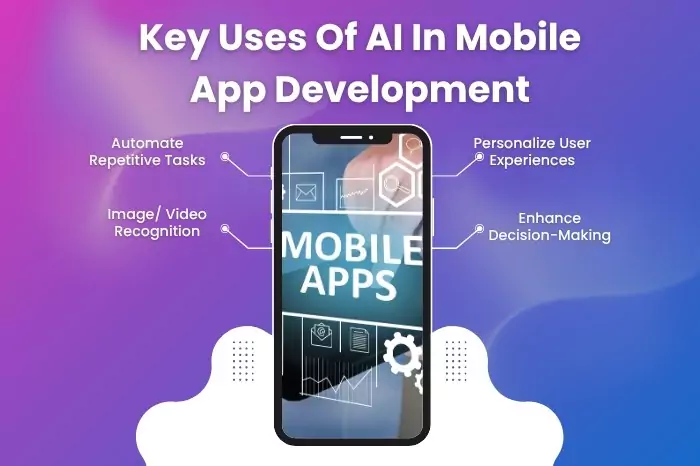Artificial Intelligence (AI) is no longer a thing of the future- it’s here, and it’s here to stay. From Amazon Alexa taking care of your home smartly to ChatGPT helping with math problems, AI is everywhere.
Smart home devices, virtual assistants, and AI-powered apps are making life easier and more efficient. Businesses are also leveraging AI to enhance user experiences, creating more intuitive apps.
According to McKinsey’s State of AI report, over 78% of organizations are adopting AI in their business, resulting in increased revenue and improved efficiency.
But how to use AI in an app effectively? This guide breaks it down for business owners and app developers. Follow the steps to seamlessly implement AI in your applications and make them smarter. Let’s get started.
5 Key Uses Of AI In Mobile App Development (With Real-World Examples)

AI is a game changer for your business. And with 83% of companies prioritizing AI/ML to stay competitive, businesses that fail to do so risk falling behind. Here’s why integrating artificial intelligence in mobile app development is a game-changer:
1. Personalize User Experiences
Today’s users expect apps to understand their preferences and offer tailored interaction. AI analyzes user behavior, such as search history, purchases, and location, to deliver dynamic content.
A great example is Spotify’s “Discover Weekly” that curates personalized playlists, driving over 40 million users regularly. AI-powered personalization increases user engagement and retention, making apps more effective and enjoyable.
2. Automate Repetitive Tasks
Manual processes are time-consuming and limit scalability. AI automates tedious tasks like data entry, fraud detection, and inventory tracking. AI-powered chatbots, such as Zendesk AI, can handle your customer queries instantly, decreasing response times and costs while increasing efficiency.
3. Enhance Decision-Making with Predictive Insights
AI provides businesses with data-driven insights into user needs and market trends. Take Uber, for example. It has a surge pricing model based on AI-powered predictive insights. It analyzes real-time data to calculate fare multipliers, allocate drivers, and balance supply and demand in peak demand periods.
4. Image/ Video Recognition
AI enhances mobile apps with advanced image and video recognition capabilities. Apps like Google Lens allow users to search for products, translate text, and identify objects in real time.
Similarly, AI-driven facial recognition in apps like Face ID improves security and authentication processes. These capabilities are widely used in social media, e-commerce, healthcare, and security applications.
However, as AI becomes more integrated into social platforms, some users are wary of how their data is used. For instance, many choose to block Meta AI Facebook, Instagram and WhatsApp features to prevent facial recognition or targeted advertising, pushing developers to offer clearer opt-out options and prioritize user trust.
5. Voice Assistants & Commands
Last but not least, voice-controlled AI assistants like Siri, Google Assistant, and Alexa have transformed how users interact with apps. They allow you to ask AI questions, that too, with hands-free operation. More accessible and user-friendly! It helps businesses improve customer experience by many folds.
An Ultimate Guide to Adding AI to Your App (No Experience Needed)
Integrating AI into your app can transform user experiences and operational efficiency. Below is a detailed guide on how to use AI in a mobile app:
1. Identify Problems And Set AI Objectives
Start by pinpointing 2-3 user or business challenges, like high cart abandonment, slow customer support, or generic recommendations. Conduct user surveys, analyze app analytics, and benchmark competitors.
Then, define clear goals to ensure a focused AI integration:
- Reduce cart abandonment by suggesting personalized products
- Improve content recommendations using behavioral data
- Automate customer support with chatbots
2. Choose The Right AI Model
Selecting the right AI model is essential for successful AI integration. Select a model aligned with your goal:
- Natural Language Processing (NLP): Use GPT-4 (OpenAI API) for chatbots or BERT for sentiment analysis.
- Computer Vision: YOLOv8 enables real-time object detection, and ResNet-50 is excellent for image classification.
- Predictive Analytics: Frameworks like TensorFlow or PyTorch work well for forecasting user behavior.
You can choose between pre-trained models (e.g., Hugging Face, TensorFlow Hub) for faster deployment. For niche applications (like medical diagnostics), custom models can be trained using frameworks like PyTorch or Scikit-learn. The right choice depends on your data, scalability needs, and the level of accuracy required for your AI-powered app.
3. Build The Front And Backend Infrastructure
While AI operates in the background, a well-designed front end ensures users interact effectively with AI-powered features. Design an intuitive UI/UX with real-time feedback to enhance engagement. For cross-platform apps, React Native or Flutter can help create seamless experiences, whether integrating chatbots or AR filters.
On the backend, scalable cloud infrastructure like AWS EC2 or Google Cloud supports AI processing, while APIs ensure smooth data flow. Using serverless functions like AWS Lambda reduces costs and improves efficiency.
4. Fine-Tune The AI Model
Pre-trained AI models offer a solid foundation, but fine-tuning them with domain-specific data ensures higher accuracy and relevance. For instance, an AI chatbot trained on customer interactions will provide more context-aware responses, improving user satisfaction.
To fine-tune effectively:
- Data Preprocessing: Clean and label data to remove inconsistencies while ensuring privacy (e.g., anonymizing sensitive user data).
- Transfer Learning: Adapt pre-trained models using tools like Keras or FastAI to fit your specific use case.
- Validation: Follow the 80/20 rule- 80% for training, 20% for validation- to prevent overfitting and ensure model reliability.
Refining your AI with quality data enhances performance and user experience.
5. Integrate The AI Model Into Your App
Once your AI model is ready, integrate it into the app for optimal performance. Use APIs like Google’s ML Kit or IBM Watson for simplified deployment without heavy hardware dependencies.
Integration comprises two main steps:
- Deployment: Implement AI using REST APIs (FastAPI, Flask) for cloud-based solutions or edge deployment (TensorFlow Lite, Core ML) for real-time, low-latency features.
- Scalability: Containerize AI models with Docker and manage workloads efficiently with Kubernetes, ensuring smooth scaling as user demand grows.
By leveraging cloud-based AI services, businesses can deploy powerful AI features while maintaining flexibility and performance.
6. Test And Optimize The Model
AI models require continuous testing and optimization to enhance accuracy and efficiency. Start with A/B testing, comparing AI-driven features with traditional systems. For example, evaluating an AI chatbot’s effectiveness against human support.
- A/B Testing: Measure how AI features impact user engagement, accuracy, and response times.
- Performance Metrics: Track key indicators like precision, recall, and F1 scores to assess model accuracy.
- Optimization: Reduce model size with quantization (e.g., TensorFlow Lite) for better mobile performance.
Use tools like MLflow, TensorBoard, and Optimizely to monitor and refine AI models based on real-world data, ensuring peak efficiency and user satisfaction.
7. Monitor And Maintain The AI Model
AI models require continuous monitoring and updates to maintain accuracy and reliability. Over time, data patterns change, which can lead to performance drift if the model isn’t adjusted accordingly.
To detect potential issues, tools like Prometheus and Amazon CloudWatch can track model accuracy and performance in real time. Retraining the model with fresh data, such as quarterly updates for fraud detection AI, ensures it stays relevant and effective.
Ethical considerations are also crucial. Using frameworks like IBM AI Fairness 360, businesses can audit their AI for bias, ensuring fairness and compliance with evolving industry standards.
Conclusion
Building an AI-powered app isn’t just about adding smart features, it’s about creating meaningful experiences for users. The success lies in the details: high-quality data, ethical considerations, and a user-first approach. Whether you’re a developer or a business owner, the key is to start small, refine continuously, and keep up with AI breakthroughs. From generative AI to IoT-drive automation, the future of app development sure has AI in it. Don’t get left behind!



